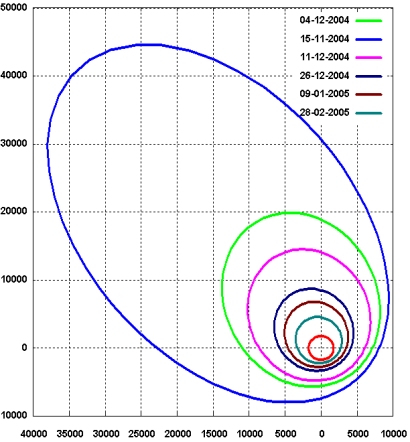No. 35 - Final Lunar Orbit & Instrument Lunar Commissioning
Unfortunately, on starting the calibration program, an anomaly occurred on board. On the night of 28 February the EP engine unexpectedly fired for about 11 hours. The cause was later traced to a recent change in the software and was subsequently corrected.
The consequence of this error is a delay in the completion of the instrument lunar commissioning of a couple of weeks. On 12 March, the ESOC Flight dynamics team commanded the spacecraft to perform an equivalent burn to compensate the unintentional one. By the start of April all the instruments should be tested and calibrated and ready to start collecting valuable science data.
Orbital/Trajectory Information
The following osculating orbital elements have been recently determined by a tracking campaign.
|
2005/02/28 05:18:39.9 Elements WRT Moon and its equator of date |
|
| Pericentre Distance (km) |
2208.658559 |
| Apocentre Distance (km) |
4618.220201 |
| Semi Major Axis (km) |
3413.439380 |
| Eccentricity |
0.352952 |
| Inclination (deg) |
90.063603 |
| Asc. Node (deg) |
236.458625 |
| Arg. of Pericentre (deg) |
286.175662 |
| True Anomaly (deg) |
180.000024 |
| Osc. Orbital Period (h) |
4.970998 |
The diagram below shows the SMART-1 osculating orbit at several dates during the spiralling in to the final operational orbit.
- The orbital period is now of slightly less than 5 hours and the inclination almost precisely 90 deg.
- This orbital period means the spacecraft maintains the same relative position with respect to the Earth ground station.
- The perilune of around 471 km and argument of 286 deg means the lowest altitude is in the Southern hemisphere at about 74 deg latitude.
- The apolune altitude is on the opposite side at around 2880 km.
- The orbital elements will vary during the operational period under the effect of the Earth gravity perturbations. The perilune will slowly decrease to about 300 km and the apolune will increase to about 3000 km, while the argument of perilune will swing around the south pole giving the highest resolution coverage in the southern hemisphere.
 |
|
SMART-1 osculating orbit up to 14 March 2005 |
Contact Points
Giuseppe Racca
SMART-1 Project Manager
ESA/ESTEC - SCI-PD
Keplerlaan 1- 2200 AG Noordwijk, The Netherlands
E-mail: Giuseppe.Racca esa.int
esa.int
Bernard H. Foing
SMART-1 Project Scientist
ESA/ESTEC - SCI-SR
Keplerlaan 1- 2200 AG Noordwijk, The Netherlands
E-mail: Bernard.Foing esa.int
esa.int

